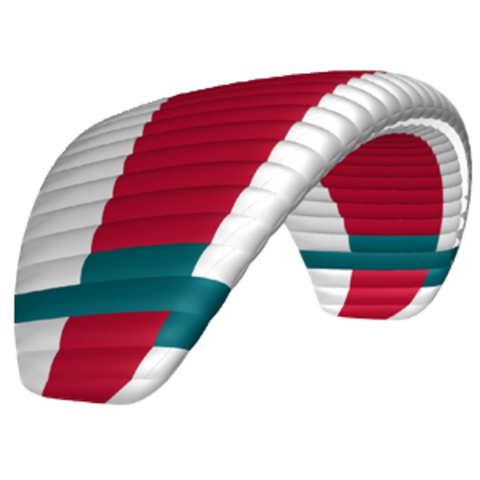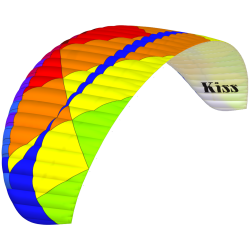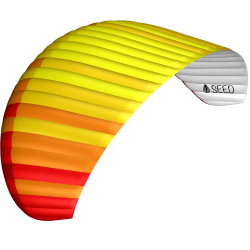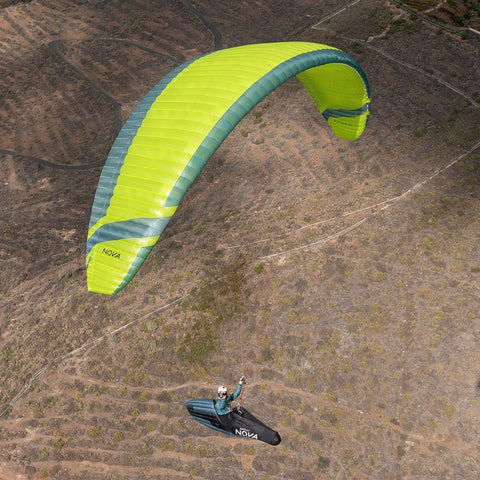NOVA Mentor 7 (EN B+)
2.5-liner | 66 cells | aspect ratio: 5.5 | weight: from 5.1 kg - size XS (EN/LTF B)
NOVA MENTOR 7 - The XC machine
The outstanding features of the MENTOR 7 are its high level of comfort when cross-country flying and its exceptional glide performance even in turbulent air. The hybrid 2.5-liner is a genuine XC machine that sets new standards in the EN B class.
REVIEWS
The Mentor 7 Light earned our trust over many flights in difficult conditions. Being so easy to fly, it saves the pilot a lot of energy, making long XC flights less exhausting and thus safer. The technology sounds impressive, and you might be intimidated during a first demo flight. But it is a benign high-B glider, especially for its performance on full bar. A big plus is the handling: it has all the advantages of easier handling of a lighter wing but none of the disadvantages, such as a delicate build or jumpy behaviour. Nova has announced a full-fat version will arrive later. The only difference will be the heavier, abrasion-resistant fabric for use on less forgiving launches than grassy hills. Other than that, we don't know what one could want differently in a full-fat Mentor 7. Link to full NOVA Mentor 7 Light review. Cross Country Magazine
NOVA Mentor 7 Light review by Dust of the Universe Ziad Bassil
NOVA Mentor 7 Light review by Down Under Paraglider Reviews - Aaron Lugg
I am a convinced EN B-pilot with 36 years of paragliding and a clear focus on XC-flying. And as you know, I am the PR guy for NOVA and also take care of the NOVA Pilots Team. So, my following post can be called biased - but I would say the same to my best friends after five beers. I have flown all MENTORs as my "main wing". On the M4, 5 and 6, I was flying them at the upper end of the weight range (or even slightly above it), in my case size S. Reasons: faster, crispier, climbing well enough on good days.
Luckily, I could try sizes S and M before wing delivery, so I changed to size M.
– It is still very, very fast,
– it is still incredibly stable and confidence-inspiring,
– I don't feel disadvantages in brake authority,
– I would even say I sense slightly more on the larger size (which was not the case with the previous models)
– it climbs better in weak conditions, of course.
In other words: it is a very nice wing for my kind of flying.
I am not the only NOVA Team Pilot who came to this conclusion. So, the MENTOR 7 (light) is not only a complete concept, it may also require to change from the paradigm that you "must" fly wings on the upper end of the weight range. That is also why we at NOVA call the extra 5kg at the upper end of the TOW “extended” and NOT “recommended”. If you fly with many clothes in the winter or go on a vol-biv, you are still within the legal range. So, my advice to all interested in the MENTOR 7 (light) is to get a test flight on both neighbouring sizes for your weight.
Happy landings Till Gottbrath
I flew Mentor 7 Light S (80-100 kg 105 kg extended) at 103.5 kg for 2 hours. Aaron Lugg flew Mentor 7 Light XS 70-90 kg 95 kg extended at 90 kg. We both flew for 2 hours. We started with the slow climb in a gaggle with many wings. Aaron outclimbed everybody. I had a better climb than some other gliders from an EN D class, keeping up with EN C gliders. The Mentor 7 tracks in thermal very well. B3 big ear is awesome, I want that big ear on all my gliders now, easy to get it in, stable while in and clean pressurised reopening. The glider is very pitch stable for high B and well-behaved on the bar in turbulent air. Pleasantly responsive with a great amount of authority with B/C steering, the best B/C steering I've experienced on any 2,5/3 liner. When we landed and exchanged notes with Aaron, our first highlight was how well these gliders climbed. The second one was how easy they are to fly. The extra 5 kg on top of the XXS, XS, S and M sizes shall be seen as an extended weight range, and when selecting the glider size, pilots should consider the standard weight range identical to all other NOVA gliders. Making the top of the ideal weight range for size XS 90kg, size S 100 kg and so on.
The NOVA Mentor 7 Light user manual says, "The MENTOR 7 Light climbs well even when flown at the higher end of the weight range. Therefore, after intensive flight tests, we have extended our usual weight ranges for sizes XXS, XS, S and M upwards by 5 kg. On epic days, this can be used to fly at a high average speed." Martin Havel
Efficient en route. The 2.5-liner design of the MENTOR 7 uniquely combines performance and comfort. Philipp Medicus, Head of R&D at NOVA, explains: “The difference in design between the MENTOR 6 and 7 is greater than between the 2 and the 6. Through this innovative approach, the performance has drastically increased without raising the demands on the pilot. The result is a cross-country paraglider that allows you to go big distances safely and efficiently."
Designed for XC. The MENTOR 7 was built for cross-country flying. Fully accelerated, it cuts solidly through turbulent air masses, and the C riser control can be used to efficiently mitigate turbulence. The safe and calm feeling when flying allows the pilot to stay focused and concentrate on tactical decisions - even on long flights. Despite its high stability, if the MENTOR 7 has collapsed, the reaction is manageable even at top speed. All NOVA test pilots confirm that this wing, with its moderate aspect ratio of 5.5, is very pleasant to fly and additionally has even more top speed than the MENTOR 6. The ideal prerequisites for new XC records.
Pitch control like a 2-liner. For optimal ergonomics, the risers of the MENTOR 7 are equipped with height-adjustable C-handles (HAC-Handles). The C-handles allow pitch control during accelerated flight, which was previously reserved for two-liners like our XENON. This means it is easy to compensate for turbulence and flying XC is far more efficient. Those with no previous experience in C-riser-control can take a relaxed approach to learning this new flight technology with the MENTOR 7 and gain a real performance advantage for themselves. Please note: how this C-riser-control works is explained in the FAQ below.
Elaborate design. In addition to the 2.5-liner concept, the MENTOR 7 is characterised by a complex inner life, 66 cells and additional rods in the rear of the wing. These design features play a vital role in the outstanding performance of the paraglider. We have cast aside our Easy Packing concept in favour of the clear performance advantage. To protect the rods, the MENTOR 7 should be packed using a Pack Roll, or wrapped around the harness, in a cell pack sack such as our Concertina Bag Light.
The risers in practice. The most prominent feature of the MENTOR 7’s new Speedbrake Riser 2.0 is the HAC-Handles. Another striking feature is the "Baby-B" line, which acts as a moveable pulley on the B3 line. This means the riser is a little more complex, but it is still clearly laid out and easy to handle even when launching. Good to know when ground handling: you can kill the MENTOR 7 very efficiently using the C-lines. As there is no C3 line, what does not work so well are asymmetric corrections via the C-lines. For lateral directional corrections, we, therefore, recommend using the brake. Please note: for more clarity during pre-flight preparation, a magnet holds the A and Baby-B risers together. For optimum launch behaviour, we recommend releasing the magnet and only holding the A-riser.
Pilot target group
The MENTOR 7 (EN/LTF B) is a state-of-the-art "teacher" in the tradition of the MENTOR series (performance, smooth in flight, safety). It does not tend to overshoot during inflation and impresses with an extreme flight behaviour that is manageable for its class. The hybrid 2.5-liner is suitable for cross-country pilots who are experienced in handling EN B gliders, or who want to get the maximum out of a flight using the speed bar and HAC handles. Anyone wishing to familiarise themselves with pitch control similar to the flying feeling of a two-liner, this is the wing to fly. It is important to understand that hybrid construction partly influences ground handling and means, for example, that the use of the B3 stall is more efficient than classic big ears.
Hybrid design as a 2.5-liner. On the outer wing, the MENTOR 7 Light is a two-liner, and in the centre a three-liner. This means this “2.5-liner” does not have a C3 line. The smart redistribution of the attachment points and a profile optimised for accelerated flying make the MENTOR 7 Light a comfortable and potentially record-breaking fast cross-country glider. At the same time, the safety and smoothness in flight remain typical of the MENTOR and accordingly the certification also resulted in EN B certification.
Speedbrake Riser 2.0 incl. HAC Handles. The MENTOR 7 Light has HAC handles (Height Adjustable C-Handles) on the newly revised riser. With these, pitch movements in accelerated flight can be compensated for in the best possible way. This means that on cross-country flights you get from A to B even more efficiently - i.e. faster and with less sink. In addition, the C riser control is very comfortable and requires little effort.
Aerodynamics optimised for speed. The design of the MENTOR 7 Light focused on speed. The profile ensures a high degree of pitch stability even at low angles of attack. In numerous simulations, the ballooning as well as the stress distribution was refined to minimise the deformation of the glider when accelerated. The cell openings are designed so that the internal pressure remains ideal even in accelerated flight. The result is excellent glide performance with an exceptional level of stability.
Technical data
Material
- Leading edge: Skytex 38 Universal, 38 g/m²
- Top surface: Skytex 38 Universal 38g/m², Skytex 40 Eazyfly 40g/m²
- Lower surface: Skytex 40 Eazyfly 40g/m²
- Profile ribs (suspended): Porcher Skytex 40 Hard, 40 g/m²
- Profile ribs (unsuspended): Porcher Skytex 40 Hard, 40 g/m²
- Main lines: Liros PPSL191 / Edelrid U-8001-130
- Gallery lines: Edelrid U-8000 / DC40
- Brake lines: Edelrid 7850-240 / Edelrid U-8000 / Liros DC40
- Risers: Kevlar 12 mm
Colours
Scope of Delivery
- NOVA Concertina Bag Light
- Speed System Cords
- NOVA Pack Roll
- NOVA Windsock
- Repair Kit
- User Manual
4 Years Manufacturer's Warranty
This Full 4-year Warranty covers material as well as workmanship. If your NOVA Trim Tuning and a NOVA Full Service were completed by an authorised NOVA partner, 4 Years On Materials comes into effect and this extends the guarantee to four years*. If we are unable to repair the problem, we will deduct the current value when purchasing a new NOVA paraglider.
More details on the manufacturer's website: NOVA
You have to have the training and a licence to fly a paraglider. Check with your instructor if you are buying your first glider.
We Also Recommend












